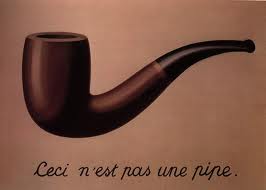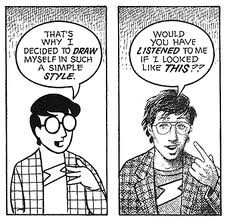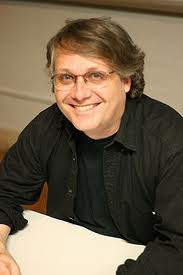Serendip is an independent site partnering with faculty at multiple colleges and universities around the world. Happy exploring!
Notes Towards Day 10 (Tues, Feb. 16): The Art of Representation

what "space" need we make here today for helling....?
also making space for the Codex Espangliensis: From Columbus to the Border Patrol
" ... some artists addressed the ironies of words and
pictures head-on!" (Understanding Comics, p. 148)
and some (like Ayla and dglasser) address it backwards...?!
(another GREAT illustration of Kathleen Fitzpatrick's
reminder that the "computer is co-writing w/ us; we
need to become literate in markup/computer languages...")
I. coursekeeping
final name test?
don't forget to do a posting over the weekend....
I've reorganized the next chunk of the syllabus, so re-fresh!...& by
Tuesday please read Marjane Satrapi's Persepolis, both parts I and II:
The Story of a Childhood (2003) and The Story of a Return (2005),
reading it (of course!) through the lens provided by Scott McCloud;
we'll spend the whole week on those texts, then do the film,
then one of the texts from Neil Gaiman's Sandman series; then
McCloud's on-line reflections about digital comics, before cutting to
whatever new material you want/we decide on together....)
II. re-framing our conversation about comics with
"frame tales" (1001 Nights, Frankenstein, Wuthering Heights:
stories w/in stories w/in stories, moving mandela-like, step-by-step
from the known/conventional to the utterly bizarre...)
"Just as the body's largest organ -- our skin -- is seldom thought of
as an organ -- so too is the panel itself overlooked as comics' most
important icon! .... the panel acts as a sort of general indicator that
time or space is beng divided ....in learning to read comics we all learned
to perceive time spatially, for in the world of comics, time and space are
one and the same. The problem is there's no conversion chart!"
(Understanding Comics, pp. 98-100)
[note multiple emphases in McCloud's text....]
sterrab: help us out w/ some physics here? explain the difference
between Euclidean space (with time as a universal constant,
independent of an observer's state of motion, vs. relativistic spacetime?
do you/we need a "conversion chart"?
(if so, can you provide it??
can we, collectively, draw it up?)

find a page where the frame matters, as an index to
the division of space/time (or? what other function does it serve?)
what about the move from the visible to the invisible....
can we find illustrative (or challenging) examples??
III. but! @ the end of Reinventing Comics,
McCloud dispenses w/ the frame (?!)...
makes it "invisible"....
pp. 233 f: "The ideas that traditional media harbor will continue to escape the shells of the technologies that brought them into being, until the irreducible essence of each has emerged--
Comics is such an idea, and most of its checkered history has been the shell...
and for comics artists in particular, thinking outside the box will soon have an additional, very literal meaning ....
No art form has lived in a smaller box than comics for the last hundred years."
so what's left of the form of comics?
... of the genre we are calling "graphic narrative"?
[on the order of leamirella's discovery,
y'day, that "school is a medium/media"?!?]
talk about a "quick" evolution from Understanding Comics!
1. record
"sequential art" (5)
space for comics = time for film (7)
history of "woodcut novels," etc (10f)
2. vocabulary
pictorial icons: cartoons simplified reality
abstraction = amplified meaning (30)
our "sketchy" sense of our own faces as masks =
primary cause of childhood fascination with cartoons (36)
deemphasize appearance of physical world, in favor of idea of form;
cartoons in world of concepts (41)
viewer identification speciality of cartooning =
"masking effect" of iconic characters (42)
objectifying power of realistic art: emphasize otherness of reader (44)
Platonic ideal of cartoon (45)
words ultimate abstraction: how different from drawing? (47)
instanteously received pictures, vs. decoded, perceived info in language (49)
(more abstracted pictures require more perception, like words;
more direct words received faster, like pictures)
picture plane: shapes, line, colors themselves, not pretending otherwise (51)
(increasingly realistic) art and (increasingly elaborate) scripts grew further apart over time (55)
triangle of values: art (picture plane)/reality (nature)/ideas (meaning) (57)
cool media (t.v., cartoons) involve audience participation through iconic forms (59)
3. blood in the gutter
fragmented perception of reality (62)
observing hte parts, perceiving the whole;
closure the agent of change, time, and motion (63)
the gutter where human imagination operates (66)
comics fracture space and time:
we make jagged reality continuous (67)
surpassed by the written word: contract between
author and silent, complicit reader (69)
craft of transitions: moment-to-moment, action-to-action, subject-to-subject,
scene-to-scene, aspect-to-aspect (standing still?), non-sequitor (70)
gutters force readers to make a whole (73)
length =space (80)
east/west split: wandering vs. goal-oreintation: being, not getting there (81)
art of intervals/omission (82)
comics is a subtractive art (85)
closure: can be intense, ambiguous, vague (86)
mono-sensory (visual) medium;
gutters require none =engage all senses: released into imagination! (89)
particular awareness of art =closure requires effort (91)
4. Time Frames
panels indicate division of time, space (99)
in comics, time = space (100)
real life = now, yet can see past and future (104)
reader can choose direction (105)
motion lines (110)
5. LIving in Line
emotions made visible, evoked; expressionism
"Art makes visible" (123); "represents the invisible" (129)
drift from visible to invisible: all language (133)
world ballon as "desperation device":
representing sound in a visual medium (134)
6. Show and Tell
convention of keeping words, pictures separate (140)
words increasingly abstract, pictures increasingly representative:
representing the invisible, vs. the visible world (144)
modernist shift: worlds increasingly concrete, pictures increasingly abstract (146)
new media judged by old standards (151)
catalogue of different word/picture combinations (154)
7. Six Steps
art: anything beyond survival or reproduction (164)
idea/form/idiom [GENRE]/structure/craft/surface (170)
8. Color
186: commerce and technology
189: objectify subjects, increase awareness of physical forms
9. Putting It All Together
194: profound isolation of us all -->
media by-products of our inability to communicate directly
199: separate form from content
207: balance of visible/invisible most conspicuous
in split of pictures from words....


